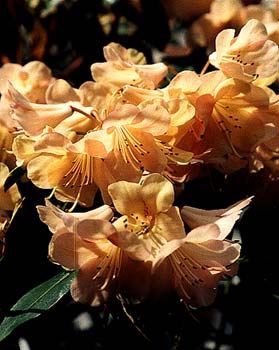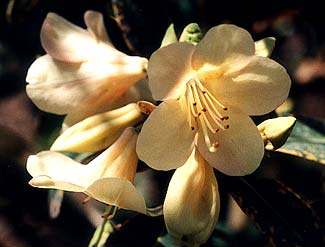 'Alison Johnstone'
'Alison Johnstone'
Bi-color Rhododendron
Buddha held between two fingers a little yellow flower. His followers became still, gazing at the Buddha's flower. For some while there was not a sound. Then the Buddha smiled, & said, "Is it I, or this humble flower, holding you rapt?"
-A Woman Inmate of the Calcutta Insane Asylum
Something always to consider when selecting a flowering shrub is what will it look like the rest of the year when not in flower. Happily rhododendrons have a wide array of leaf forms — round, or lanced, or large, or small, in sundry shades of green with occasional leaves of mahagony or red. Therefore when the colorful blossoms are not in season, having planned planting choices to express variety in leaf shape & coloration keeps a collection of rhodies from appearing monotonous when not blooming. The present semi-dwarf cultivar has roundish green leaves with yellow edging.
The 'Alison Johnstone' bi-color hybridized by the George Johnstone (d. 1960). He named it for his wife (d. 1970), who was born Alison Hawkins, & shown in the portrait on this page. George inherited an extensive estate in Cornwall in 1904.
 He set about shortly thereafter to establish an extensive shrub garden within the older extant woodland gardens of his ancestors. The result was to become the world famed Trewithen Gardens open to the public March through September.
He set about shortly thereafter to establish an extensive shrub garden within the older extant woodland gardens of his ancestors. The result was to become the world famed Trewithen Gardens open to the public March through September.George Johnstone produced this, the most famous of his hybrids, from the Chinese alpine dwarf R. yunnanense pollinated with the Tibetan R. cinnabarinum ssp. xanthocodon (Concatenans). The resulting shrub has the general form of its pollinator. It's a compact, upright, broadleaf evergreen whose new leaf growth is bright green but quickly darkens to bluish green, then develops the pale yellow fringe, unlike just about any other rhody leaf.
If it gets too little sunlight, the sharply delineated yellow leaf-edging may be less evident or not present at all. But with too much sun, the yellow edging tends to wash out unattractively with brown bits indicating sunburn. I first planted it in a bright area where it did show signs of heat stress, so before it was too settled in, I moved it to a place with only morning sun.
 The buds offset the unusual leaf coloration with a clear, unmarked yellowness sometimes called golden amber, but I don't find it as bold a color as that description implies. When the buds first begin to open they are a pallid mauve, almost leaf-like in coloration, but when fully opened, the dangling trusses are a buttery gold occasionally flushed with pale peach or apricot, fading to white if too sun-exposed.
The buds offset the unusual leaf coloration with a clear, unmarked yellowness sometimes called golden amber, but I don't find it as bold a color as that description implies. When the buds first begin to open they are a pallid mauve, almost leaf-like in coloration, but when fully opened, the dangling trusses are a buttery gold occasionally flushed with pale peach or apricot, fading to white if too sun-exposed.'Alison Johnstone' was registered in 1958 & not introduced to gardening generally until 1969; but it had been around some while before it was registered, having received the Award of Merit from the Royal Horticultural Society in 1945.
It can become a mid-sized shrub with an average ten-year height of four or five feet, which is larger than either of the parent species. Our youngster (in 2002) was only about two feet by two feet with a most pleasingly mature-looking upright form. It blooms most extravagantly in mid to late April, when the portraits on this page were taken.